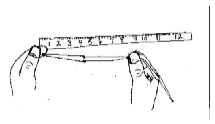|
NETS For hundreds and thousands of years Alaskans have developed methods to catch fish. The most common method today is with nets. There are two kinds of nets: seine nets and gill nets. |

|
Seine nets surround the fish and hold them in an enclosed area until they are hauled flopping into the boat or ship.Gill nets catch fish around the head, holding the gills closed. The fish quickly die because they cannot get oxygen over their gills. They struggle less, making them better tasting. As they struggle less, they tangle the nest less.
Most subsistence families use gill nets. If the meshes of the gill net are too big, fish swim through it or get hung up on their dorsal fin.
If the gill net is too small, the fish hang up for a while around their nose, but can easily escape.
Having a net with the proper mesh size for local fish is most important. When people made nets from sinew and willow bark, it was very important to have an efficient net, as they were so hard to make.
Parts of a net
There are several parts to a net.
|
Float line. This holds the top of the net to the surface of the water so fish cannot swim over the net. Lead line. This holds the bottom of the net down so the fish cannot swim under the net. Mesh. This is the part of the net that catches
the fish. |
Float line
Lead line |
HOW BIG SHOULD THE NET BE?
Measure around the gills of at least ten fish of a single species your family uses, whether silver salmon, red, chum, humpies, different kinds of whitefish, grayling, trout, shea fish etc. The best way to do this is to wrap a string around the fish at the gills, then measure the string.



 Net
depth is measured in meshes, whether 25 meshes deep, 28, 35 etc.
As the net, when it is hung, doesn't hang with the meshes
perfectly square, it's impossible to determine the length by
calculating. You just have to measure a net. Of course, a red
salmon net 28 meshes deep isn't the same depth as a whitefish net
28 meshes deep, as the mesh size is different. However, once you
know, for example, that a net 28 meshes deep is 8', you should be
able to compute the depth of a net 36 meshes deep.
Net
depth is measured in meshes, whether 25 meshes deep, 28, 35 etc.
As the net, when it is hung, doesn't hang with the meshes
perfectly square, it's impossible to determine the length by
calculating. You just have to measure a net. Of course, a red
salmon net 28 meshes deep isn't the same depth as a whitefish net
28 meshes deep, as the mesh size is different. However, once you
know, for example, that a net 28 meshes deep is 8', you should be
able to compute the depth of a net 36 meshes deep.